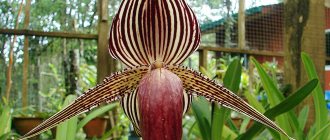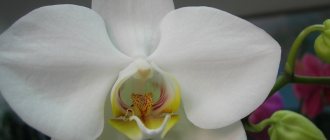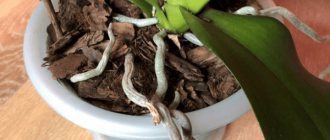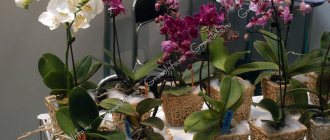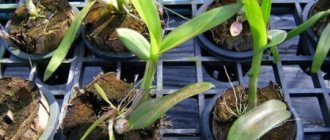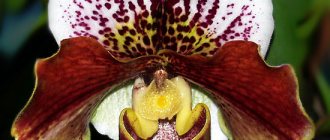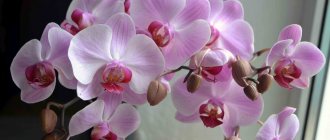Golden Beauty is a hybrid orchid, coming from the phalaenopsis genus, which means it is undemanding to the conditions of its maintenance and is distinguished by its prolific flowering. With proper treatment, it lives for a long time, without becoming a burden for its owner, decorating the house with delicate buds, and also filling the air with a divine aroma. Find out from this article why the plant is interesting, how to care for and propagate it, and also what diseases and pests are dangerous to it.
Origin and history of the species
Phalaenopsis Beauty Golden is an epiphytic orchid artificially bred by breeders. Its ancestors come from the countries of Southeast Asia and Australia. They live there to this day, preferring to settle mainly in trees and less often on rocks.
We find the first mention of phalaenopsis in the diaries of the German naturalist Georg Rumph. At the end of the 17th century, he visited the island of Ambon, part of the Moluccas archipelago, where he saw an amazing flower.
The scientific description of the orchid was assigned almost two centuries later - in 1825 by Karl Blum, head of the Leiden Botanical Garden. He traveled to Southeast Asia, where on one of the small islands he discovered a flower resembling a moth.
The plants in question quickly became popular in Europe. The price of orchids turned out to be extremely high. So many botanists were able to make considerable fortunes by breeding them.
Around the same time, work began on creating new varieties, as a result of which the flower discussed in this article appeared.
Detailed description of the Golden Beauty orchid
The flower has all the specific characteristics that allow it to be classified specifically as a phalaenopsis.
The culture has wide, elongated leaves. They are distinguished by their rigidity, fleshiness, skin density and glossiness. The shade is deep green.
Peduncles are standard in height for most phalaenopsis - up to 0.6 m, branched, erect. They grow from the axils, like aerial roots. The stem is short and is lost in the leaf rosette.
Phalaenopsis variety Beauty is unpretentious, blooms magnificently and abundantly. The buds smell pleasant and have a diameter of up to 80 mm. The number of shades is amazing.
Orchids found:
- golden;
- ocher;
- pale pink;
- lilac;
- motley.
The lip is usually distinguished by a contrasting, predominantly crimson or crimson color. Petals can be velvety, matte or waxy.
Features of an orchid
The Golden Beauty variety is not found in nature. At the same time, there are no anatomical differences between it and natural species.
Our flower, however, has stronger immunity, it quickly adapts to new conditions and is very unpretentious. This allows it to be grown and propagated even by those owners who are not too experienced in the intricacies of keeping phalaenopsis.
Advice: with proper care, Golden Beauty blooms steadily and for a long time, produces a lot of buds and does not cause any special trouble for the owners. However, it is necessary to disturb the orchid less - it does not tolerate overprotection.
Phalaenopsis varieties Golden Beauty, photo
The Elegant Beauty variety is very interesting. This orchid is distinguished by variegated blooms. The petals are decorated with complex patterns consisting of dark brown dots of different sizes. The main color is soft purple.
Solid gold (Solid Gold) produces two peduncles at once. Their height reaches an average of 0.4 m, but sometimes exceeds 0.8 m. The plant produces medium-sized (about 45 mm) buds of an almost traditional shape for phalaenopsis. Their color is peachy-gold, and the petals are decorated with not too flashy stripes. The culture can bloom for up to 2 months.
Brother Sara Gold (Brother Sara Gold) is another variety of Beauty orchid. This variety has small buds, bright pink in the center and golden towards the edges. Additionally, they are decorated with stripes and small, brick-colored specks.
Gold Leopard produces whimsical, angel-like flowers in a lilac hue. In the center there is a pattern of burgundy dots on an almost white background. The lip is light, with an orange border.
Golden Tresor is a light purple orchid whose petals are decorated with stripes and beige streaks at the tips. The velvety surface of the flowers gives additional charm to phalaenopsis.
These are not all Beauty varieties; there are about twenty-five of them. Unfortunately, it is impossible to describe them all within one article.
Common varieties of orchids with photos
Solid Gold
Solid gold. The most popular variety among golden phalaenopsis. It has two flower stalks that appear every six months. Flowering continues for eight weeks. The height of the plant is about 60–80 cm; its cost also depends on the height of the flower. Despite its large height, the orchid requires a standard pot with a diameter of 12 centimeters.
Jaguar
Golden Jaguar. The petals are yellow in color. The plant blooms every six months, and the flowering period lasts about eight weeks. This variety does not like frequent watering, so it is most often grown in transparent pots to understand when watering is required.
This species adapts well to indoor conditions.
gold fish
Golden Fish. A medium-sized orchid with orange-pink flowers and veins. The lower petal is pink or orange in the shape of a lip.
Beauty
Golden Beauty. This variety has large flowers (9–10 cm) with a bright red lip. It is formed curved, as it reaches a great height (up to 0.8 m). The flowering period is two months.
Leopard
Golden Leopard. Reaches a height of 70 centimeters. The flowers are dense, rich yellow with burgundy splashes. The diameter of the flowers is approximately 9 cm. The plant lives for about 15 years.
Brick (Golden Brick)
Golden Brick. The flower is pale orange with a yellow edge and a pink lower lip. The height of the orchid is 50 cm. The dimensions of the flower are 8–9 centimeters.
This variety is sometimes confused with the Surf Song variety due to the similar color of the petals. What is the difference between the Surf Song variety can be seen here.
Apple
Golden Apple. This species is often confused with the Golden Rush, as they are visually very similar. But there are still differences. Apple's flowers are yellowish in color, the peduncle is 50–55 cm high and the buds are brighter. The bud also has the shape of a regular five-leaf clover with a burgundy-yellow lip.
Pixie
Golden pixie. The flowers are bright yellow. The plant has a small height when compared with other species, only 15–20 cm. The diameter of the flower is 5 cm. They are classified as mini-orchids.
Sara (Brother Sara Gold)
It is considered a midi orchid, since the height of the peduncles is approximately 30–40 cm. The flowers themselves are small (3–5 cm), they are bright yellow and have a special aroma reminiscent of caramel. Flowering occurs every six months and can last about 12 years.
Rush
Gold Rush. A rare peach-colored flower with veins and a red lip. It has two peduncles, and one is covered with buds and flowers, its height can reach 70 cm. And the second one collects buds while the first one is flowering and its height is already smaller, only 45 centimeters.
About flowering
As a rule, an orchid produces buds at least twice a year, but sometimes (under ideal conditions) they appear three times in the same period of time.
Flowering lasts from 1.5 to 3 months. It usually starts in November. In order for the phalaenopsis to release its arrow, it must be cared for especially carefully from the beginning of spring until the end of summer.
During this period it is important:
- carry out proper watering;
- apply fertilizers in a timely manner;
- ensure proper lighting levels.
When flowering is completed, the orchid goes into a dormant state that does not last too long. At this time, it is important not to disturb the culture, because it needs to gain strength to begin a new cycle of life.
Important: after the buds wither, the peduncle is removed. Cut it off with a sterile knife, moving about 20 mm away from the dormant bud. It is advisable to begin treating the latter with a growth stimulator at the same time.
Delayed flowering occurs due to too much care. A little stress will help here. Reduce watering and at the same time ensure that the temperature in the room decreases to +14 °C...+15 °C. After 15 days, restore the usual conditions of detention.
Increasing the difference between day and night temperatures is also considered an effective way. Here you need fluctuations within 4-6 degrees.
Bloom
The flowering characteristics of varieties with a leopard pattern on the petals are different:
- Belamkanda chinensis blooms in the summer, from July to September. In autumn, seed pods appear that look similar to blackberries.
Comment! The lifespan of individual leopard flowers is only two days. Afterwards the petals curl.
- Flowering of odontoglossums at home occurs in October-May. During rest, the plant needs to lower the air temperature to +200 C, reduce humidity and reduce watering.
- The Yellow Leopard Orchid delights with the appearance of flowers every 6 months. Flowering duration is up to 2 months. Over time, a healthy plant increases the number of flower stalks.
Care step by step
Golden Beauty is not known for her capriciousness, but she still needs to create acceptable living conditions. We'll tell you how to do this in detail.
Place
It is necessary to place a pot with phalaenopsis near windows facing east or west. A less good choice is the south side of the house - it can be too hot here in the summer. For this reason, you will have to think about sun protection.
The northern direction is a very bad option. If there are no others, then it is necessary to provide the plant with an artificial light source.
The second thing that is important to pay attention to is drafts. Cold air is very harmful to orchids. They begin to get sick, rot and die. Also make sure there are no fans or air conditioners nearby.
Substrate and pot
Traditional Beauty containers are suitable - transparent, equipped with holes located not only on the bottom, but also in the walls. A completely successful and inexpensive option is a plastic container.
Instead of pots, it is not forbidden to take baskets or baskets, as well as special blocks made of wood. All these materials do not retain air, do not heat up and absorb excess moisture well.
The soil needs to be loose and light. A ready-made one produced specifically for orchids will do. If you intend to make the substrate yourself, then first find out what the humidity is in your home.
If the indicator is low, use this ratio in parts:
- pine bark – 3;
- sphagnum moss – 3;
- charcoal – 1.
For damper rooms, take only the first and third components, adding only a little peat to them.
Before placing the substrate in the pot, you need to put a layer of drainage material.
Here's a good choice:
- expanded clay;
- fine gravel;
- pebbles;
- shells.
Advice: it is better not to take polystyrene foam; it eventually ends up on the surface of the ground.
Temperature
In summer, the orchid prefers air that heats up to +20 °C...+24 °C. The limit is +30 °C, but the flower will only withstand it if you spray it with water daily.
There is a second option - place the pot on a wire rack, and place it on a tray filled with expanded clay and water. Make sure that the roots of the orchid do not touch the latter.
In the autumn-winter season, phalaenopsis is more suitable at a temperature of +17 °C...+22 °C. For the rest period, the most acceptable is +12 °C…+14 °C.
Humidity
The representative of the phalaenopsis variety in question does not suffer too much when it finds itself in a room with dry air. This property distinguishes it very favorably from other orchids.
It is enough for the flower if the humidity level fluctuates between 35% -60%. In hot weather, it is advisable to give the plant a warm shower or spraying.
Do not forget to periodically ventilate the room; this helps prevent many diseases, whose pathogens love dampness and stagnation.
Lighting
Like all phalaenopsis, this species feels comfortable when not in direct contact with the sun.
The culture likes diffused but strong light. If there is not enough of it, the leaves often stretch out and turn pale. Once under the scorching sun, the plates darken and can get burned.
In winter, and also when it is cloudy, at dusk, turn on the phytolamp for at least 4-5 hours.
Watering
Only purified water is used (filtered or boiled). The temperature cannot be below +30 °C or above +35 °C. It’s good if the acidity is insignificant, but this is not important.
In summer, water twice a week. Let the substrate dry on the surface and wait until the condensation disappears from the walls of the pot. In winter, less fluid is required - give it a maximum of 2 times within 7 days.
The best option for watering is immersion. Place the container with the orchid in a bucket of water and remove it after 20 minutes. Next, wait a quarter of an hour for excess moisture to come out.
Fertilizers
Fertilizing should be done during the active growing season, that is, start the season in the spring and end in the fall. It is best to use formulations made directly for orchids; they contain all the necessary microelements.
Additionally, in March it is worth giving a little nitrogen to stimulate the growth of stems and green mass. During other periods, take care of potassium and phosphorus.
Advice: it is best to give fertilizer at the same time as water.
Transfer
The flower is not very favorable to any changes in conditions of detention, and therefore reacts painfully to being transferred to a new pot and soil. Nevertheless, this procedure is still required, but not more often than once every 3 years.
Outside the schedule, a transfer is given if:
- the root system has grown too large;
- the substrate began to emit a sour smell;
- there are signs of some disease.
The finished soil, provided that its packaging has been sealed, can be placed in the pot immediately. Homemade mixtures must be sterilized by boiling or steam.
Planned replanting should be delayed until flowering is complete.
The procedure is as follows:
- place the pot with the orchid in a bowl of warm water - after soaking it is easier to remove;
- remove the copy by holding the lump against the socket and turning the container upside down;
- Use a knife (not just a clean one, but a sterile one) to separate all diseased or damaged roots;
- rub the wounds with crushed coal and let them dry for an hour;
- place drainage in the pot;
- place the plant on top;
- Fill the free space (strictly up to the root collar) with substrate.
Reproduction of Phalaenopsis Golden Beauty
The vegetative method can be used immediately after flowering, while the arrow has not yet dried out. Cut it diagonally above the bud. Be sure to treat the wound with activated charcoal or cinnamon.
Place the peduncle in a jar with water and a stimulant, and place it in a greenhouse. Keep at +25 °C. The light needs to be diffused. Change the fluid every three days.
In about a week the first roots will appear. Following this, the cutting is transplanted into the substrate, but is kept in a protected environment until the active growing season begins.
If a baby forms on a flower, then everything is much simpler. Wait until the young shoot grows roots at least 5 cm long. Then carefully separate it from the mother specimen and, after moistening it with a stimulant, plant it in a small pot with soil (a disposable transparent cup will do). Until final rooting, it is better to keep the baby in a greenhouse.
Growing problems
Reproduction methods
- Breeders and specialists develop new varieties and grow new plants from seeds. Honor and respect for them for new varieties. But this is quite a complex process;
- And you can increase the family of your pets at home children's department. There's no way you won't notice them. After all, they will have their own roots and leaves;
- They can grow from leaf axils or on a peduncle from dormant buds;
- They themselves tend to appear infrequently. You can take the initiative in their growth yourself. But all this applies to mature and healthy plants;
- How to do it? Change the conditions: Reduce watering;
- Place in a cooler room for a short time.
Baby on a peduncle.
Not only the children that appear will allow you to propagate the desired variety. But also their flower stalks:
- Cut off the peduncle and place it in a closed container with water and fertilizer in a greenhouse;
- You can divide the cut peduncle into several cuttings with buds in the middle. And again to the greenhouse.
Important! An increase in humidity and temperature is necessary. As does adding nitrogen fertilizer.
Diseases and pests
Phalaenopsis sometimes become infected with viruses. Such ailments do not manifest themselves for a long time, but become more active when suitable conditions are created. There is no cure. Fortunately, the diseased flower does not die, but may become deformed or change the shade of the petals.
Bacterial infections, as well as fungi, take root when phalaenopsis care leaves much to be desired. Their appearance is indicated by spots of different shades, traces of rotting, as well as loss of turgor.
Treatment is carried out using antibacterial or fungicidal drugs. In addition, the flower must be transplanted into a new pot and soil. It is also important to remove any damaged areas.
On hot, dry summer days, the risk of pests increases. Phalaenopsis varieties Beauty are threatened by:
- scale insects;
- spider mites;
- mealybugs;
- aphids.
Insecticides will help get rid of them:
- Aktofit;
- Fitoverm;
- Ambush.
Isolate the diseased specimen, wash with soapy water and spray with the chosen product. Repeat the treatment after 7 days.
Important: do not interrupt quarantine earlier than 2 weeks have passed. This is guaranteed to protect other plants in the house from infection.
Features of keeping at home
You need to start caring for your leopard orchid immediately after it appears on the windowsill. The first task of the florist is to quarantine the new “tenant”. Watering and fertilizing should be postponed. At this time, monitor the condition of the leaf blades and root system.
Important! You cannot immediately transplant the plant into a new container, especially if it is blooming.
Basic content rules:
- Lighting. The preferred place in the house is windows facing south with shading during the midday hours. The recommended daylight hours are about 14-16 hours. In winter, it is artificially prolonged with the help of phytolamps.
- Temperature conditions. For tropical plants, the air temperature is comfortable within +180-250 C.
- The planting container must correspond to the size of the root system in order to avoid crowding, poor air permeability and at the same time avoid stagnation of moisture due to overflow.
- The substrate must be selected based on tree bark. The bottom of the pot should be lined with medium-sized pieces of bark.
- Humidity in room conditions should be at least 40%. To maintain it, it is fashionable to place a tray with pebbles under the flower pot and add water to it. It is better to avoid spraying, as if liquid gets into the axils of the leaves, rot can occur. And when direct sunlight hits the leaf plates with droplets of water, burns form.
- The regularity of watering should be determined by the condition of the substrate. Water the plant after it dries completely. To do this, use boiled or filtered water.
Prevention of various problems
If you care for the flower correctly, water it in a timely manner and in the proper amount, and also fertilize it, then it is unlikely to cause you any inconvenience.
Additional protection of plants from pests is preventive spraying with Fitoverm solution. Once a month, dilute the drug twice as much as usual, and treat both the orchid itself and the substrate.
Don't forget to sterilize your instruments - wipe them with alcohol. If you have to cut out damaged areas, then disinfection must be carried out after each stage.
Make sure that the temperature in the room always remains within the permitted limits. Prolonged cold spells lead to frostbite, and heat leads to drying out.
Golden Beauty is the most elegant variety of phalaenopsis, capable of living up to 14 years in comfortable conditions. Organize proper care for the flower, water and fertilize it in a timely manner, and replant it regularly. This is the only way you can enjoy its unfading beauty.
Care
Optimal conditions of detention
To create optimal conditions for keeping phalaenopsis you need:
- Place the plant in a bright place without direct sunlight ;
- Florists prefer windows on the east side. But Western ones are quite suitable;
- If you want them to bloom, highlight them .
Remember! For good growth, the plant needs to be in the light for about 14-15 hours. Use phytolamps.
Create the microclimate of their homeland. Maintain the desired temperature and humidity:
- In summer - no higher than 30 degrees. And for the plant, 23-25 degrees is better;
- And in winter it should not be lower than 16-18 degrees.
- Ensure proper and timely watering and fertilizing.
After purchasing in store
- Do I need to replant after purchasing it in a store? Of course it is necessary. The capacity is too small. Sphagnum moss should be replaced with real soil;
- But do this after it has finished blooming.
Step-by-step transplant scheme.
Some advice from flower growers! Use garlic to repel pests. Both the cloves in the container and the garlic infusion.
Watering and fertilizing
What needs to be done carefully is watering. But nothing complicated:
- During the flowering period once a week;
- In winter - once every 10 days;
- Choose morning hours.
Watering methods:
- Spraying. To maintain moisture and good flowering, it is recommended even 3-4 times a day. But don't touch the flowers. They may be offended;
- Watering the soil from a watering can;
- Immerse the container halfway in the prepared water. For a couple of hours. And give the water a chance to escape on its own.
Important:
- Monitor the condition of the leaf axils. Water should not stagnate there. Gently wipe the leaves from any drops of water;
- Carry out preventive treatments with a weak solution of potassium permanganate;
- Use distilled water for watering;
- The water temperature should match the air temperature.
Fertilize with fertilizers once every 2 weeks from the beginning of flowering in the summer. In winter, once a month is enough. After flowering, stop feeding. Use Kemira. Plantafol with Megafol. Or special complex fertilizers marked “For orchids”.
Plantafol can be used as a fertilizer.
How to stimulate flowering?
In order not to sit and wait for the orchid to bloom on its own, you can encourage it to do so. This is facilitated by lowering the temperature during the winter months and reducing watering.
Pruning after flowering
Follow the rules of pruning and recommendations for its implementation:
- Select trim time . Take your time to cut immediately after flowering. A flower may bloom on a green peduncle;
- Trim only the wilting and drying parts . Leave a small stump (2-3 cm). Be sure to treat the cut areas;
- The most suitable time is October-November;
- Do this with a clean, disinfected instrument ;
- Do not hesitate to consult the flower shops where you purchased these plants.
Notice! Some experts say that not pruning can encourage the orchid to bloom again. Not every one of them is able to do this. It is better to gain strength during the rest period.
Prevention of diseases and pests
- He can only blame himself for the occurrence of diseases and pests of phalaenopsis. Even if they brought it from the store or received such a gift;
- Poor quality care and uncomfortable living conditions also introduce diseases : Leaf spot;
- Powdery mildew;
- Fungal diseases and various rots (late blight, anthracnose and others);
- Sunburn;
- All parts can be affected: roots, leaves, flowers.
Powdery mildew on an orchid.
- pests may also appear (spider mites, aphids, thrips, mealybugs);
- In order not to shout “Guard!”, provide the proper conditions for the plants: This includes temperature, lighting, watering, fertilizing;
- Properly selected containers and soil;
- Ventilation of premises;
- Preventive treatments with fungicides;
- Replacing the substrate.
- Have your own first aid kit for orchids: Fungicides (Fitosporin, Skor, Vectra);
- Potassium permanganate and charcoal;
- Insecticides (Fitoverm, Aktelik);
- Soapy water solutions.
Very important:
- Be careful and attentive when purchasing in stores. No stains, rust, blisters or damage;
- Quarantine new pets. Separate from everyone.
